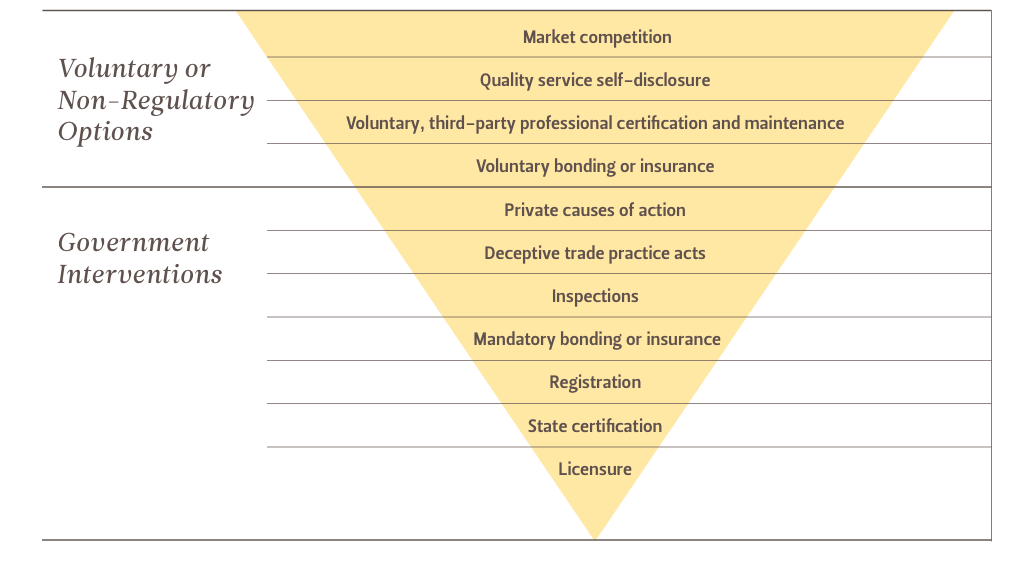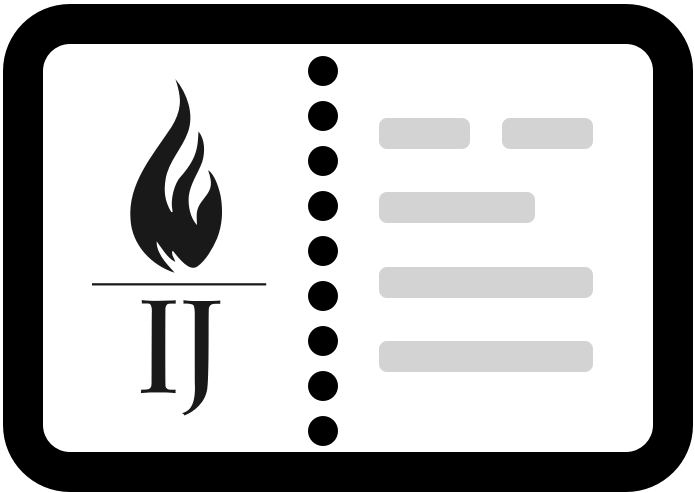To License or Not to License: A False Choice
Occupational insiders alone cannot take all the credit for the growth of licensing in recent years. They could not achieve licensure without the aid of accommodating legislators. Indeed, licensing’s growth has likely stemmed, in part, from policymakers’ proclivity for erring on the side of “doing something” when they see their options as action or inaction—licensing or no licensing. Given such a binary choice—and in the face of industry assertions that licensing is necessary to protect public health and safety—legislators may be more likely to choose licensing to be “better safe than sorry.”
Yet this choice is a false one that ignores a whole range of other regulatory options between no licensing and licensing.1 These options are listed in Figure 4, from least to most restrictive.
Figure 4: The Inverted Pyramid
A Hierarchy of Alternatives to Licensing

In many cases, such alternatives can protect the public as well as or better than licensing without imposing its costs. The top four options, which can be considered voluntary or “non-regulatory,” are:
(a) Market competition. Market competition takes the primary position in the inverted pyramid’s hierarchy because open markets with no or limited government intervention provide the widest range of consumer choices, allocate resources more efficiently and give businesses strong incentives to keep their reputations as providers of high-quality services.2 When service providers are free to compete, consumers weed out providers who fail to deliver safe and quality service. They do this by 1) denying repeat business to such service providers and 2) telling others about their experience.
Proponents of licensing often claim it is necessary to overcome the problem of asymmetrical information, which is when service providers have more or better information than consumers, potentially giving them an advantage in the marketplace.3 Licensing is thought to solve this problem by providing a “seal of approval,” signaling to consumers that practitioners possess the skills and knowledge necessary to provide safe and quality service.4 But governments may have no better information than consumers, or they may be subject to “capture” by private interests, resulting in needless licensing that restricts consumer choice without delivering any benefits.
Innovations in the private marketplace, however, can reduce information asymmetries without licensing’s downsides. For example, thanks to the internet, today’s consumers have at their fingertips copious amounts of information about service providers. Reviews on social media, advice blogs and services like Angie’s List, Thumbtack, HomeAdvisor, Houzz and Yelp have proliferated in response to consumer demand. And these reviews often offer far more detailed and useful feedback than simply knowing whether a provider is licensed. This market response shows how market forces can help level the informational playing field for consumers and weed out incompetents and fraudsters more quickly and effectively than licensing.5
(b) Quality service self-disclosure. Service providers themselves can help solve the “information problem” through self-disclosure—that is, by proactively sharing information about how previous customers have rated the quality of their goods and services. Occupational practitioners can link to third-party evaluation sites from their websites to provide consumers with an important competitive “signal” that they are open to disclosure regarding their service quality. Practitioners without websites can exercise this option by providing prospective customers with lists of past customers or other references who can provide information about them. And consumers can spur disclosure by demanding such information as a condition of doing business.
(c) Voluntary, third-party professional certification and maintenance. Another way service providers can help address the problem of asymmetrical information is by voluntarily pursuing and maintaining certification from a non-governmental organization. Like licensing, third-party certification sends a signal that an occupational practitioner has attained a certain degree of education or experience. But unlike licensing, it does so without creating any barriers to entry. It therefore provides the purported benefits of licensing while avoiding the pitfalls, including higher costs and fewer services for consumers. Third-party certification is already in use for nurses, automotive occupations, respiratory therapists, counselors and crane operators, to name just a few occupations, with many firms voluntarily making such certifications a requirement for employment.
(d) Voluntary bonding or insurance. Some occupations pose greater risks to consumers than others. Voluntary bonding and insurance allow practitioners of such occupations to outsource management of risks to bonding or insurance companies, which will provide a guarantee of protection against, respectively, a provider’s failure to fulfill an obligation (e.g., a moving company’s failure to deliver goods by the agreed date) or losses from theft or damage by the provider. This option is already in common use among temporary personnel agencies, janitorial companies and companies with government contracts.
The next six options are government interventions that, although more restrictive than the non-regulatory options above, are nevertheless less restrictive than licensure:
(e) Private causes of action. Private causes of action give consumers the right to bring lawsuits against service providers who have injured them. Where they do not already exist, legislators can create them. The existence of such rights may compel providers to adopt standards of quality to avoid litigation and an accompanying loss of reputation. The cost to consumers of obtaining a remedy could be reduced by allowing them to sue in small claims court or, if suing in district court, to collect court and attorneys’ fees when their claims are successful.
(f) Deceptive trade practice acts. All 50 states and the District of Columbia already have deceptive trade practice acts, consumer protection laws that allow attorneys general and consumers to sue service providers engaged in certain practices deemed false, misleading or deceptive and permit enforcement agencies to prosecute them. Such deceptive trade practice acts are an important and frequently used means of protecting consumers from predatory and unscrupulous business practices.6
(g) Inspections. Inspections are already common in some settings. For example, many municipalities use inspections to ensure restaurant hygiene, favoring them over onerous licensing of food preparers, wait staff and dishwashers. In other settings where the state may have a legitimate interest in instrument or facility cleanliness, inspections may be sufficient and preferable to new or existing licensing. Periodic random inspections could also replace the licensing of various trades, such as electricians, carpenters and other building contractors, where the application of skills is repeated and detectable to the experienced eye of an inspector. Where inspections are already used as a complement to licensing, states may find that inspections alone suffice.
(h) Mandatory bonding or insurance. For some occupations, a system of mandatory bonding or insurance can be a better alternative to full licensure. Voluntary bonding or insurance is generally preferable, but states may prefer a mandatory requirement when the risks associated with the services of certain firms extend beyond just the immediate consumer. For example, the state interest in regulating a tree trimmer is in ensuring that the service provider can pay for repairs in the event of damage to power lines or the home or other property of a party—a neighbor, for instance—not involved in the contract between the firm and the consumer. Because tree trimming presents few other threats, states can achieve this objective through bonding or insurance requirements while allowing workers to otherwise practice freely. Similarly, while many states require construction contractors to comply with expensive and burdensome licensing laws, Minnesota requires only bonding for HVAC contractors.7 If that occupation can be practiced freely and safely with only bonding as a requirement, the same is likely true of other trades both in Minnesota and in other states.
(i) Registration. Registration requires service providers to provide the government with their name, their address and a description of their services. Registration can complement private causes of action because it often requires providers to indicate where and how they take service of process in the event they are sued. However, the simple requirement to register with the state may be sufficient in and of itself to deter bad actors.
(j) State certification. Like voluntary, third-party certification, state certification overcomes the problem of asymmetrical information by sending a signal to potential customers and employers that an occupational practitioner meets certain standards. However, state certification differs from third-party certification in two major respects. First, the certifying body is the government rather than a private association. And second, state certification restricts the use of an occupational title—though not, as licensing does, the practice of an occupation. Under state certification, anyone can work in an occupation, but only those who meet the state’s qualifications can use a designated title, such as certified interior designer or certified financial planner. Third-party certification is generally preferable because state certification requires new or expanded government bureaucracy, which comes with costs. Further, third-party organizations are likely to be more responsive to industry and consumer trends. Nevertheless, state certification is less restrictive than occupational licensing and presents few costs in terms of increased unemployment and consumer prices.
Finally, at the bottom of the inverted pyramid’s hierarchy is licensure, the most restrictive form of occupational regulation. Only where there is proof of demonstrated, substantial harms from an occupation that cannot be mitigated by one of the less restrictive options in the above menu should policymakers consider this regulation of last resort.


